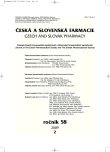HPLC study of temperature influence on some enantiomer separations of sulfoxides, determination of some enantiomers of sulfoxides in rat serum
Authors:
D. Meričko 1; J. Lehotay 1; J. Čižmárik 2
Authors‘ workplace:
STU v Bratislave, Fakulta chemickej a potravinárskej technológie, Ústav analytickej chémie
1; Univerzita Komenského Bratislava, Farmaceutická fakulta, Katedra farmaceutickej chémie
2
Published in:
Čes. slov. Farm., 2009; 58, 71-77
Category:
Review Articles
Overview
The methylated-teicoplanin aglycone chiral stationary phase (CSP) was used to study the enantioseparation and temperature behaviour of a set of chiral sulfoxides – nine different aryl methyl sulfoxides, 1-methylsulfinylnaphthalene and 1,1-dimethyl-2-phenylethylsulfinylbenzene in polar organic mode. The effect of temperature on the HPLC separation of aromatic sulfoxides was studied between 10 °C and 50 °C in methanol mobile phases with different concentration of the organic modifier in mobile phase composition. The van’t Hoff plots (ln k versus 1/T and ln α versus 1/T, where k is retention factor, T is temperature of chromatographic column, and α is selectivity coefficient) were constructed and thermodynamic data were determined from the slope and the intercept of linear van’t Hoff plots for all 12 racemic compounds under the study. The van’t Hoff plots were linear for all enantiomers. (S) (+) enantiomeric form was eluted as the first one in any case. Solid phase extraction (SPE) was used for the determination of sulfoxides and clean solutions after SPE was injected into a chiral column. The mobile phase was methanol containing acetic acid (17.48 mmol/l) and diethylamine (4.79 mmol/l). The limits of determination (LOQ) were calculated for all compounds under study. The LOQ values were in the range from 7.0 to 24.2 ng/ml, the recovery of extraction was in the range from 82% to 96%.
Key words:
separation of chiral compounds – methylated teicoplanin CSP – sulfoxidies – solid phase extraction – HPLC
Sources
1. Beesley, T. E., Scott R. P. W.: Chiral Chromatography. Chichester: NS Wiley 1998; 242–243.
2. Lämmerhofer, M., Lindner, W. Valkó, K.: Separation Methods in Drug Synthesis and Purification Amsterdam: Elsevier 2000; 381–382.
3. Jandera, P., Bačkovská, V., Felinger, A.: J. Chromatogr. A, 2001; 919, 67–77.
4. Berthod, A., Xiao, T.L., Liu, Y., Jenks, W.S., Armstrong, D.W.: J. Chromatogr. A, 2002; 955, 53–69.
5. Armstrong, D.W., Liu, Y., Ekborg-Ott, K.H.: Chirality, 1995; 7, 474–497.
6. Lokajová, J., Tesařová, E., Armstrong, D.W.: J. Chromatogr. A, 2005; 1088, 57–66.
7. Aboul-Enein, H. Y., Ali, I.: Farmaco, 2002; 57, 513–529.
8. Xiao, T. L., Tesařová, E., Anderson, J. L., Egger, M., Armstrong, D.W.: J. Sep.Sci., 2006; 29, 429–445.
9. Yamanoi, Y., Inamoto, T.: J. Org. Chem., 1997; 62, 8560–8564.
10. Delouvrie, B., Fensterbank, L., Lacote, E., Malacria, M.: J. Am. Chem. Soc., 1999; 121, 11395–11401.
11. Padmanabhan, S., Lavin, R. C., Durant, G. J.: Tetrahedron Asymmetry, 2000; 11, 3455–3457.
12. Cotton, H., Elebring, T., Larsson, M., Li, L., Sorensen, H., von Unge, S.: Tetrahedron Asymmetry, 2000; 11, 3819–3825.
13. Carreno, M. C.: Chem. Rev., 1995; 95, 1717–1760.
14. Walker, A. J.: Tetrahedron Asymmetry, 1992; 3, 961–998.
15. Cass, Q. B., Kohn, C. K., Calafatti, S. A., Aboul-Eneim, H. Y.: J. Pharm. Biomed. Anal., 2001; 26, 123–130.
16. Schuetz, R. D. , Ciporin, L.: J. Org. Chem., 1958; 23, 206–209.
17. Borwell, F. G., Pitt, B. M.: The formation of α-chloro sulfides from sulfides and from sulfoxides. J. Am. Chem. Soc., 1955; 77, 572–578.
Labels
Pharmacy Clinical pharmacologyArticle was published in
Czech and Slovak Pharmacy

2009 Issue 2
Most read in this issue
- Beta-blockers
- On the terms pharmaceutical care, pharmacy care, and good pharmacy practice
- Beneficial effects of rutin, quercitrin and quercetin on inflammatory bowel disease
- Use radionuclide x-ray fluorescence analysis for determination of heavy metals content in dextrans in solid and liquid state
